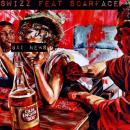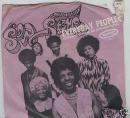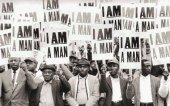A shot rings out in the middle of the night
There’s a dead man on Tulsa’s northside
But there ain’t nobody naming names
Except a newspaper man with an axe to grind
He says “Its real simple. It goes like this:”
“Black man gave a white woman a kiss”
“So let’s rise up and burn him down,
“cause there ain’t no room for that in our town”
But the truth is this ain’t about an embrace
It’s the age old struggle to hold down a race
They had the Black Wall Street, and millionaire Jews,
Native Nations worth billions in crude
Yeah the oil flowed with opportunity thick
There were too many people, and they were getting rich
And with some folks that don’t sit too well
So one day that axe it fell
The mob crossed Greenwood, Archer bound
They burned the Baptist Church of Zion down
They were shooting left, they were shooting right
The fire blocked the stars in the sky
There was blood in the streets and bodies everywhere
The carnage left 35 blocks bare
That paper said the dead were 23
But there were 500 missing families
Well the folks left standing they split fast
All the dreams they were building reduced to ash
Teachers, Doctors, Lawyers, and preacher men
Had seen their fair share of blood and sin
And there was this thing about history that they understood
Telling them to leave town while they still could
So if you’re in downtown Tulsa and your looking around
At all the empty lots where the highway’s laid down
With all the semis and the cars just passing through
You’ll know that path was laid by a wrecking crew
And if your cross the tracks that separate that town
There’s a mass grave buried in the ground
A disgrace they hid beneath the red dirt clay
You’ll hear nothing but a whisper today
There’s a dead man on Tulsa’s northside
But there ain’t nobody naming names
Except a newspaper man with an axe to grind
He says “Its real simple. It goes like this:”
“Black man gave a white woman a kiss”
“So let’s rise up and burn him down,
“cause there ain’t no room for that in our town”
But the truth is this ain’t about an embrace
It’s the age old struggle to hold down a race
They had the Black Wall Street, and millionaire Jews,
Native Nations worth billions in crude
Yeah the oil flowed with opportunity thick
There were too many people, and they were getting rich
And with some folks that don’t sit too well
So one day that axe it fell
The mob crossed Greenwood, Archer bound
They burned the Baptist Church of Zion down
They were shooting left, they were shooting right
The fire blocked the stars in the sky
There was blood in the streets and bodies everywhere
The carnage left 35 blocks bare
That paper said the dead were 23
But there were 500 missing families
Well the folks left standing they split fast
All the dreams they were building reduced to ash
Teachers, Doctors, Lawyers, and preacher men
Had seen their fair share of blood and sin
And there was this thing about history that they understood
Telling them to leave town while they still could
So if you’re in downtown Tulsa and your looking around
At all the empty lots where the highway’s laid down
With all the semis and the cars just passing through
You’ll know that path was laid by a wrecking crew
And if your cross the tracks that separate that town
There’s a mass grave buried in the ground
A disgrace they hid beneath the red dirt clay
You’ll hear nothing but a whisper today
envoyé par Dq82 + Bryan Hembree - 26/12/2019 - 12:14
×
![]()






Rag and bone
Words & Music by Bryan Hembree
98 years ago today Greenwood was burning. Known then as the "Black Wall Street" Greenwood, on the edge of Downtown Tulsa was one of the most affluent African American business districts and communities in America. In the span of 36 hours a mob burned it to the ground. By most accounts, hundreds of Greenwood residents lost their lives. A horrific tragedy. As a kid growing up in Tulsa in the 1980's, the story was rarely talked about. It shocked me and saddened me and so many other Tulsans, but it was a mere undercurrent. It had happened so long ago, and been talked about so little that some people treated it more as a myth than the reality and tragedy it was. When I was writing this song 10 years ago, I tried to imagine what Woody Guthrie or Bob Dylan would have said had then written about the Greenwood massacre. I remember feeling that Woody was telling me, "just sit down and write the damn song". Today, both Woody Guthrie's archives and Bob Dylan's archives are housed in Tulsa. The Woody Guthrie Center literally sits at the edge of the part of Greenwood that burned. As a young musician growing up in Tulsa I could have never dreamed that both Woody and Bob would find a home in Tulsa. We got word last night that Greil Marcus played our song before his keynote speech at the Bob Dylan World Symposium at the University of Tulsa. The symposium marks the official opening of the Bob Dylan archives to scholars and researchers. A big thanks to Greil for the mention. May we all never forget what happened in Tulsa 1921, and never repeat the hatred and violence of those 2 days. -
Bryan Hembree
Facebook
Il conflitto civile, avvenuto sia via terra che attraverso mezzi aerei, portò alla distruzione totale di più di 35 isolati del distretto, a quei tempi abitato dalla più vasta comunità afroamericana della nazione. Più di 800 persone ebbero bisogno di cure mediche e più di 6.000 residenti vennero fatti arrestare e molti di questi rimasero detenuti per diversi giorni. L'"Oklahoma Bureau of Vital Statistics" registrò solo 39 morti ufficiali, ma altre fonti riportarono fino a 175 vittime; la Croce Rossa Americana in un rapporto del 2001 ha stimato il numero delle vittime del massacro ad almeno 300, quest'ultimo dato viene sostenuto anche dagli storici contemporanei.
I tumulti scoppiarono nel corso del fine settimana seguente al Memorial Day, dopo che un giovane afroamericano venne accusato di aver commesso violenza sessuale contro un'addetta adolescente agli ascensori in un edificio commerciale. Dopo essere stato preso in custodia giunsero voci alla comunità nera che stesse per rischiare il linciaggio, pertanto un gruppo di afroamericani armati si precipitò alla stazione di polizia dov'era trattenuto il sospetto nel tentativo d'impedirlo; ma nel frattempo si era radunata anche una folla di bianchi.
La situazione evolvette presto in scontro aperto, vennero esplosi diversi colpi di arma da fuoco ed alcuni uomini, bianchi e neri, rimasero uccisi. Mentre la notizia si diffondeva in tutta la città esplose la violenza incontrollata della folla; migliaia di bianchi si accanirono contro la comunità nera per tutta quella notte fino al giorno seguente: vennero assassinati uomini e donne, bruciati e saccheggiati negozi e abitazioni private. Almeno 10.000 afroamericani rimasero senza tetto, i danni alle proprietà ammontarono a più di 1,75 milioni di dollari per i beni immobili e a 750.000 per le proprietà personali (pari a 30 milioni di dollari del 2017).
Alcuni cittadini afroamericani sostennero che gli stessi poliziotti si unirono agli assassini[2], altri che uomini della National Guard of the United States spararono con una mitragliatrice in mezzo alla gente inerme e che un aereo lanciò stick di dinamite[5]. Grazie alla testimonianza oculare dell'allora procuratore distrettuale Buck Colbert Franklin - rinvenuta nel 2015 - si è venuti a sapere che dozzine di guardie di sicurezza privatevennero inviate dalle forze di polizia a bruciare essenza di trementina sui tetti con l'intento premeditato di scatenare incendi dolosi.
Molti dei sopravvissuti lasciarono Tulsa. Sia i residenti bianchi che quelli neri rimasti mantennero il più rigoroso silenzio per decenni a causa del terrore causato dalla violenza folle e dalle perdite di persone care in quel tragico evento. La rivolta è stata in gran parte omessa, sia localmente sia statalmente, oltre che dagli storici nazionali: "la sommossa razziale di Tulsa del 1921 è stata raramente menzionata nei libri di storia, nelle aule scolastiche e addirittura in privato dai neri e dai bianchi allo stesso modo; sono cresciuti fino alla mezza età del tutto inconsapevoli di ciò che fosse realmente accaduto in quel luogo".
Nel 1996, 75º anniversario della rivolta e con il numero dei sopravvissuti ai fatti in rapido declino, un gruppo bipartisan di parlamentari statali ha autorizzato la formazione di una Commissione d'inchiesta nel tentativo di accertare storicamente i fatti; i membri sono stati nominati - oltre che per indagare sulle dinamiche - anche per ascoltare e registrare i testimoni rimasti e così produrre un documento pubblico. Il procedimento si è sforzato di dare un'informazione il più adeguata possibile.
La relazione finale, che è stata fatta pubblicare nel 2001, ha affermato che buona parte della popolazione cospirò con la folla bianca contro la comunità nera ed ha raccomandato un programma di riparazione per i sopravvissuti e i loro discendenti. L'Oklahoma ha approvato un disegno di leggeche istituisce delle borse di studio a favore delle famiglie colpite, incoraggia lo sviluppo economico del territorio e istituisce un parco commemorativo in ricordo delle vittime. Il parco è stato inaugurato nel 2010.
Wikipedia
Dopo essere stato riportato all’attualità dalle scene iniziali della serie tv di Hbo ‘Watchmen’, che si apre proprio con le immagini dei disordini razziali del 1921 – quando una folla di bianchi assaltò un quartiere di afroamericani – ora gli scienziati sono convinti di aver trovato le fosse comuni di Tulsa.
businessinsider.com